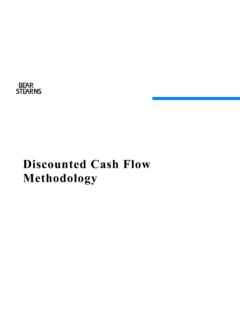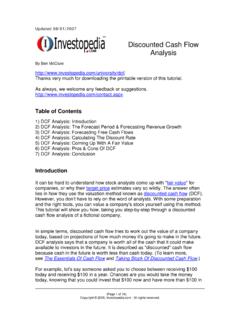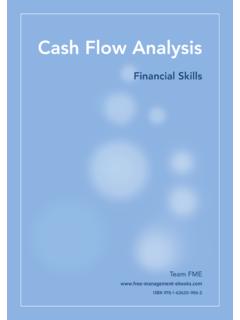Transcription of AN OVERVIEW TO CASH FLOW & LIQUIDITY FORECASTING
1 AN OVERVIEW TO CASH FLOW & LIQUIDITY FORECASTING2 AN OVERVIEW TO CASH FLOW & LIQUIDITY FORECASTINGI ntroductionThe ability for companies to accurately predict future cash and LIQUIDITY needs is certainly important. Effective cash FORECASTING results in more efficient use of capital, reduced financing costs and less risk. The skill of effective cash FORECASTING , however, is a challenge for treasuries to master. If proof is needed, just attend an annual meeting of the Association of Financial Professionals (AFP). The recent conference in Washington featured multiple cash flow FORECASTING sessions all filled with a standing-room only crowd. Why? Although technology has made it easier to gather, communicate and analyze data, the challenges of globalization, increased financial complexity, extensive regulatory requirements and lack of systems integration contribute to the difficulty of producing an effective cash flow forecast.
2 What can be done to improve FORECASTING effectiveness? What are the proper elements of a forecast? What are good sources of data? How do you determine which time frames to use and what modeling techniques are appropriate? What are the unknown unknowns that reduce forecasts to rubble in the blink of an eye? And, what is the differ-ence between a cash flow forecast and a LIQUIDITY forecast? This paper will answer these questions and discuss some of the available tools that can help treasury professionals achieve a high degree of visibility into future cash flows and LIQUIDITY positions. Finally, we will present Financial Sciences Corporation s (FSC) vision for cash FORECASTING and LIQUIDITY management in ATOM, the treasury management system designed, developed and implemented by FSC.
3 AN OVERVIEW TO CASH FLOW & LIQUIDITY FORECASTING3 AN OVERVIEW TO CASH FLOW & LIQUIDITY FORECASTINGG oals and ObjectivesOne of the first steps is to establish clear FORECASTING goals and objectives. Some treasury groups want to produce a forecast each month while others must track availability and LIQUIDITY each day. Some treasuries are satisfied with a rolling 7-day forecast, while others require a daily, 12-month forecast. Ultimately the time granularity and duration of the fore-cast is determined by the nature and requirements of a company s underlying operations. Some common FORECASTING goals include the ability to produce: A rolling daily seven-day forecast to ensure adequate funding of daily operations A rolling monthly forecast going out 12 months for visibility on longer term cash availability A cash forecast upon request A 12-month rolling LIQUIDITY forecast to ensure long-term funding Forecast scenarios based on changes in underlying assumptions Regardless of the FORECASTING time frame, treasuries should seek to achieve visibility on two distinct levels: 1.
4 Cash balances and cash excesses or shortfalls from daily Additional sources or uses of cash from credit agreements, investments, debt programs and other sources that may be used to remediate any identified cash excesses or TechnologyThere are various technologies available to help organizations organize, analyze, and process cash flow data. Spreadsheets and specialized FORECASTING software, such as those provided by a Treasury Management System (TMS), are the two most popular choices. Spreadsheets, which have been around for decades, are still widely used by companies of all sizes. Their popularity is fueled by their low cost and high flexibility. Many of the FORECASTING tools available from TMS software vendors are unfortunately designed by programmers (not treasury professionals), so they tend to be complex, inflexible or not sufficiently robust.
5 The challenge for treasury software providers is to create tools with the level of flexibility needed for effective cash flow FORECASTING not just for one client or industry, but for clients of different sizes, industries and geographies. ATOM, the enterprise treasury and risk system by Financial Sciences, takes a uniquely graphical workflow approach to cash flow FORECASTING and LIQUIDITY management. Figure 1 shows ATOM s cockpit for FORECASTING and LIQUIDITY management. ATOM cockpits combine navigation, functionality, drill-downs, workflow, reporting and business intel-ligence in one home screen. Cockpits like this are available for every functional area within ATOM, whether managing payments, commodity risk or accounting journal entries. CASH FLOW FORECASTINGPA R T I4 AN OVERVIEW TO CASH FLOW & LIQUIDITY FORECASTINGA utomation, Data Integration and ModelingEvery business is different.
6 Some businesses can forecast an entire year with relative ease because they have a small number of relatively predictable cash flows . Other busi-nesses that have many entities, thousands of bank accounts and millions of cash flows have challenges just to organize their data. Add the complexity of multiple Enterprise Resource Planning (ERP) systems, multiple banking platforms, and a plethora of stand-alone spreadsheets and it is no surprise that companies cannot produce effective fore-casts when needed. Treasury management system technology can help by addressing three key areas: automation, data integration and modeling. Automation does several things. Most notably, it allows treasurers to become more efficient in running the company s treasury operations.
7 Automation can eliminate the need to manually download, parse, classify and reconcile bank statement activity. For smaller organizations with one bank and a few accounts, automation might not save much time. For more diverse and complex treasuries, however, automation can have a huge impact from a cost, time and resource savings perspective. Automation enables the ability to integrate data. A goal for any TMS should be to have all data in one system and one database. Having one system with the right applica-tion tools will eliminate the need to rely on external spreadsheets. A fully integrated system will also help aggregate and incorporate data from ERP and General Ledger (GL) systems. With payments, deals/trades, balances, credit facilities, investments and other information in one place, there is no need to rekey information, so errors are reduced, quality increases and overall efficiency improves.
8 FIGURE 1. ATOM FORECASTING and LIQUIDITY Management5 AN OVERVIEW TO CASH FLOW & LIQUIDITY FORECASTINGAn integrated platform enables others within the organization business units, region-al and/or country finance managers to participate in the FORECASTING process result-ing in a more complete view of overall operations. Integration facilitates the gathering of data, which can then be organized, dissected and sliced and diced for a granular look at projections. Cash forecasts can be quickly compiled, saving time for more productive, value-added is the third important component. Comprehensive treasury management systems provide analytics that include functionality to model and predict cash forecast-ing activity using historical and integrated data as model inputs.
9 Cash PositionThe first step in creating a cash forecast is to create a cash position. A cash position should provide a real-time view of today s cash balances at a minimum by bank, bank account, currency and entity. Balances should be summarized by inflow and outflow categories such as lockbox deposits, debt and investment maturities, payroll, controlled disbursements, leases, etc. Figure 2 shows a simple cash position in view shows current and/or prior-day balances and activity. Without an automated system, it can take considerable time to retrieve bank-reported activity and compile a comprehensive cash position. Although most treasury management systems retrieve and record bank activity automatically, many systems do not have the ability to analyze transactions for automatic matching and categorization.
10 FIGURE 2. Monitoring Daily Cash Positions6 AN OVERVIEW TO CASH FLOW & LIQUIDITY FORECASTINGC ompanies find it useful to categorize cash flows into 10 or 15 different categories. The cash position view can be extended to compare actual to forecast as shown in Figure 3. Comparing the current cash position s forecasts to actual cash flows is an important step in going from a basic cash position to a full cash flow forecast. The experience gained from FORECASTING cash flows on a daily basis will be used to forecast cash flows for the future. Organizing cash flows by categories that reflect the nature and timing of underlying business operations has two important benefits: 1) it provides transparency throughout the day as different types of cash are reported and can be eliminated from forecast uncertainty, and 2) it promotes a divide and conquer approach with regard to developing effective strategies to construct reliable FORECASTING data whether from analyzing cash history, feeds from other systems, or via consulting with business units.





